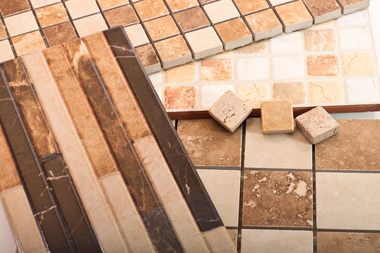One of the most important factors to consider when updating or remodeling your bathroom is the type and style of flooring that you will use. Before you pick materials on “looks” alone, use these tips to help you find the right match.
Tip #1: Explore all of your options for types of flooring.
Vinyl. It’s the most popular choice for bathroom flooring, and for a good reason. Vinyl typically comes in 6- or 12-foot-wide rolls, making installation a snap. Using vinyl rolls can achieve the seamless look that many homeowners prefer. Another popular option is vinyl squares or tiles, which are easier to handle and install, but have more seams that can collect dirt and mildew. Vinyl flooring comes in a multitude of colors and patterns, ensuring that homeowners can find a design that will work in their bathroom.
Carpet. While this is not most people’s first choice for bathroom flooring, there are plenty of water and stain-resistant carpeting options that could work great for your bathroom. Carpet has the added bonus of being warm and soft, something that you will not find using cold tile or stone building materials.
Ceramic tile. This typically comes in squares that are between ½ inch and ¾ inch thick and measure anywhere from 4 inches by 4 inches to 24 inches by 24 inches. When you are choosing ceramic floor tiles, it is important to check on the porosity rating. For a moist environment such as a bathroom, you will want to choose a type of tile that is as minimally porous as possible.
Hardwood. Many people like the warm look of hardwood flooring, and if you have hardwood floors throughout your house, extending them into your bathroom can help create a cohesive look.
Laminate. A type of layered flooring that is resistant to damage and easy to clean, laminate is a popular choice for busy families. This type of flooring is relatively affordable, allowing you to give your bathroom a new, clean look without breaking the bank.
Natural stone. This kind of flooring is usually cut into square tiles. Many varieties come in 12 inch by 12 inch squares, but some manufacturers prefer larger or smaller tiles depending on the type of stone. This material is easy to care for and keep clean, but one important consideration is whether your subfloor is strong enough to support this heavy building material.
Tip #2: Shop around.
Different vendors might have drastically different prices for similar flooring materials, so make sure you get a few quotes before you make your final purchase.
Tip #3: Measure carefully!
The last thing you want is to run out of flooring before you finish remodeling your bathroom, so try to make sure you purchase a little bit extra, just in case. This is especially important if you are using stone or ceramic tiles ”“ it is common for a few tiles to crack or break during transport.
Once you have purchased your flooring materials, you will be well on your way to having an up-to-date bathroom floor.


